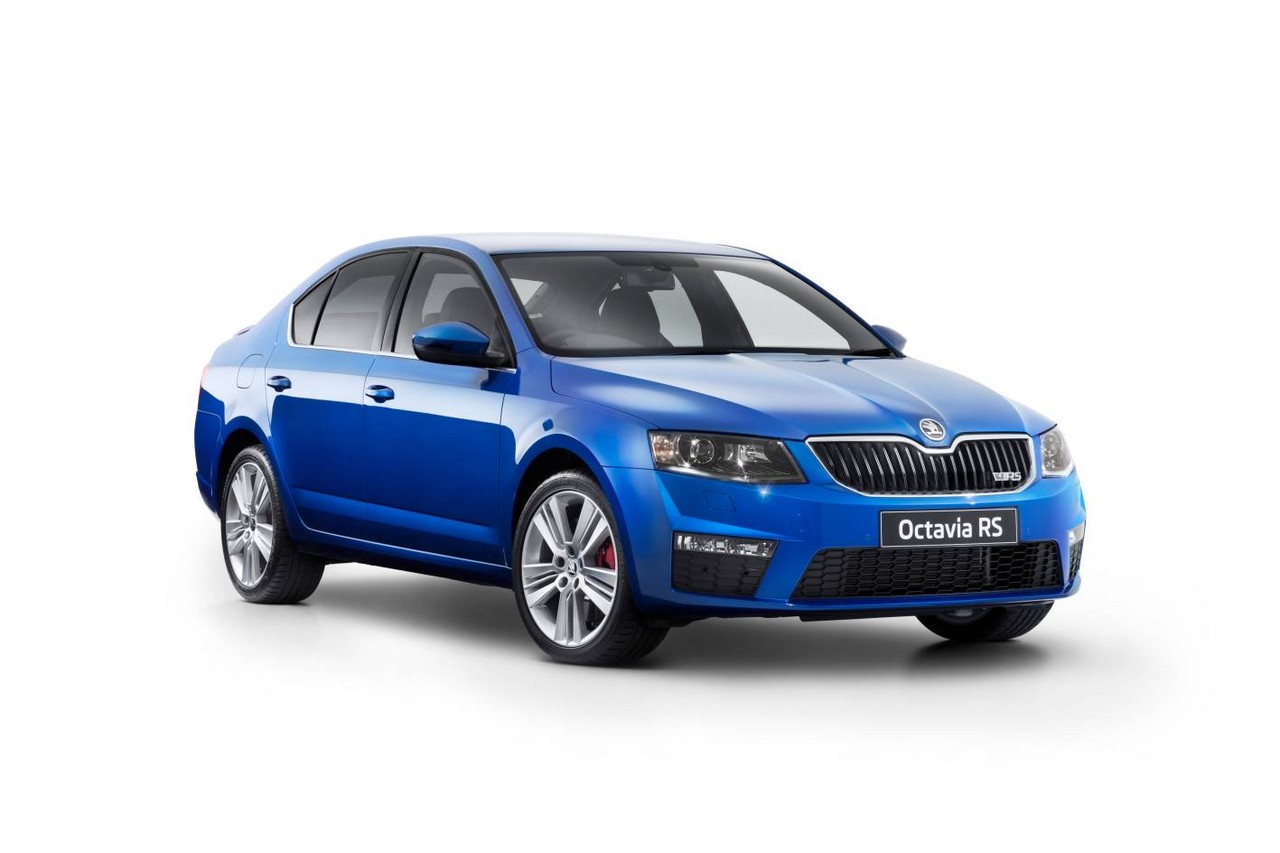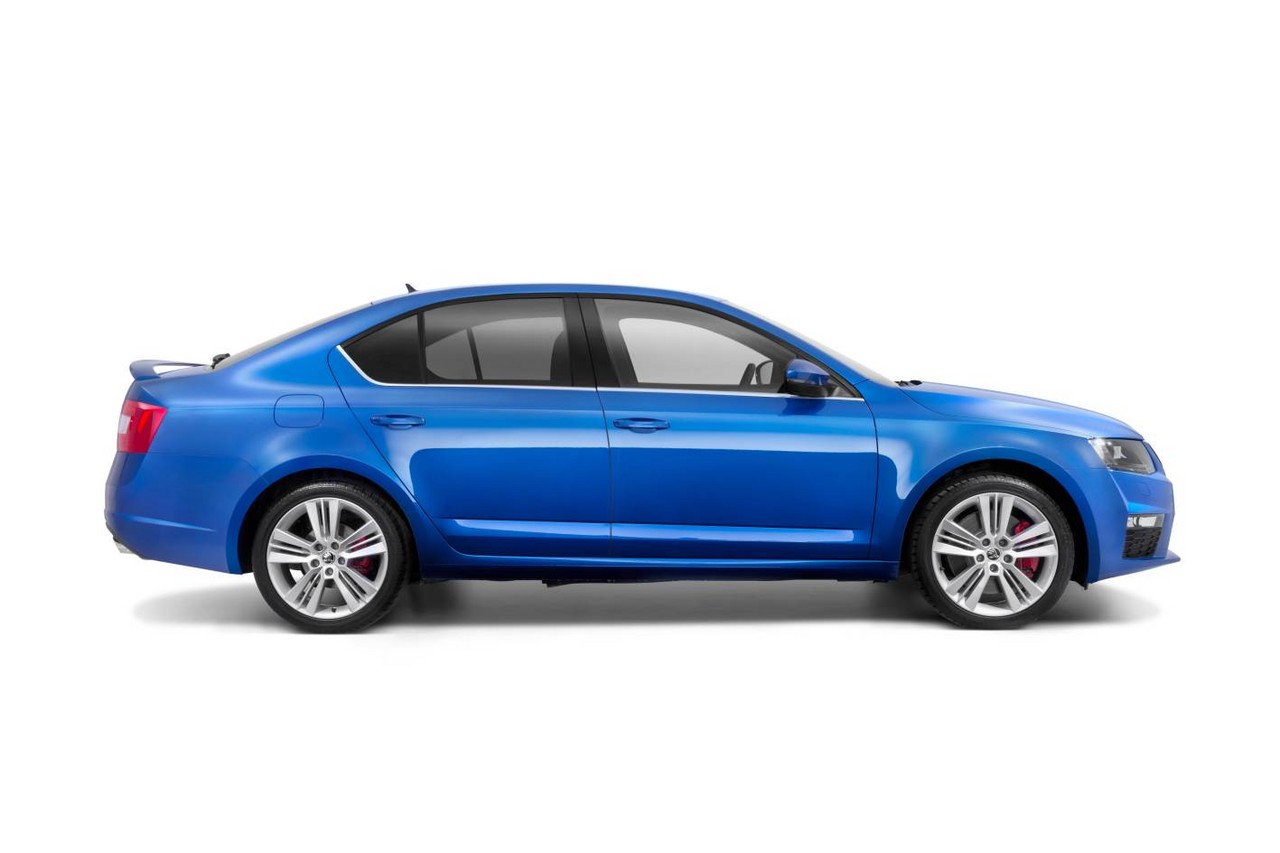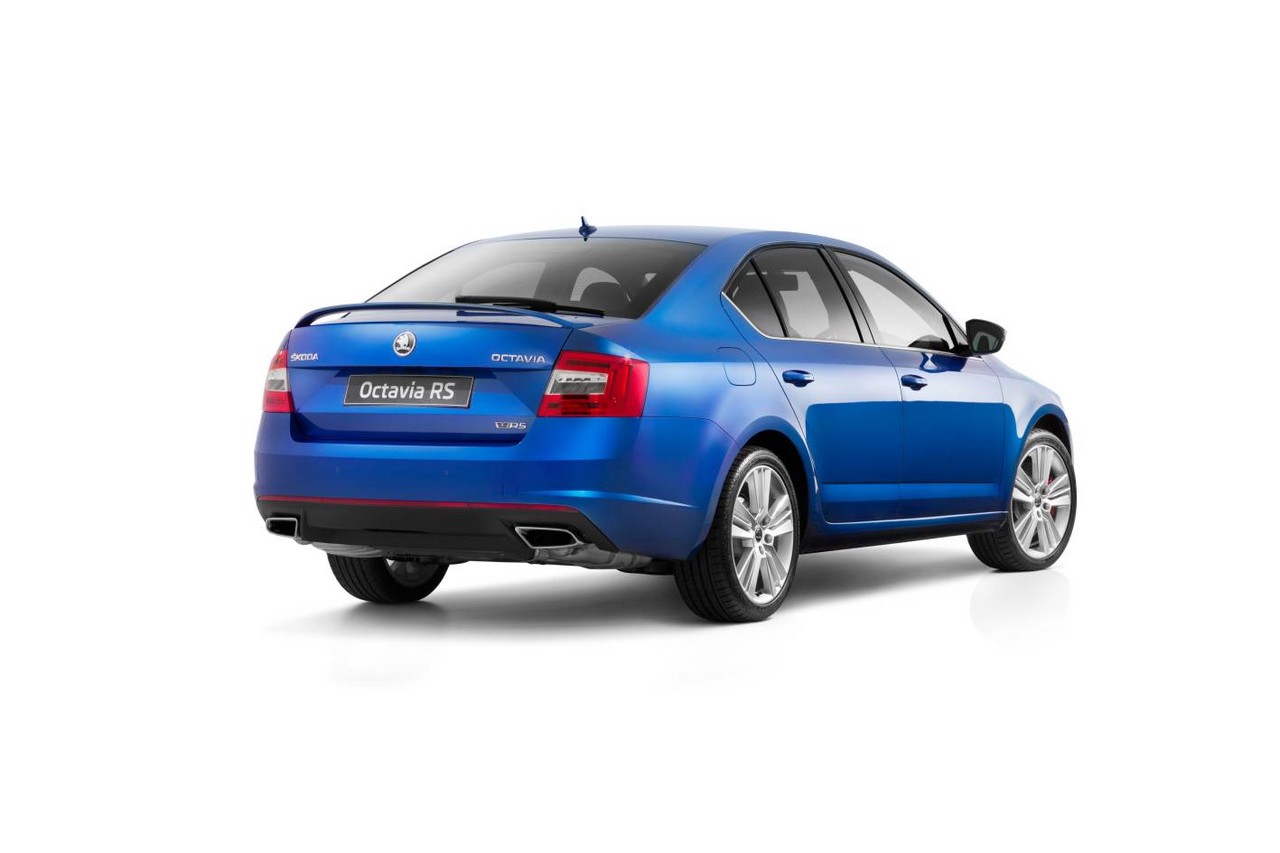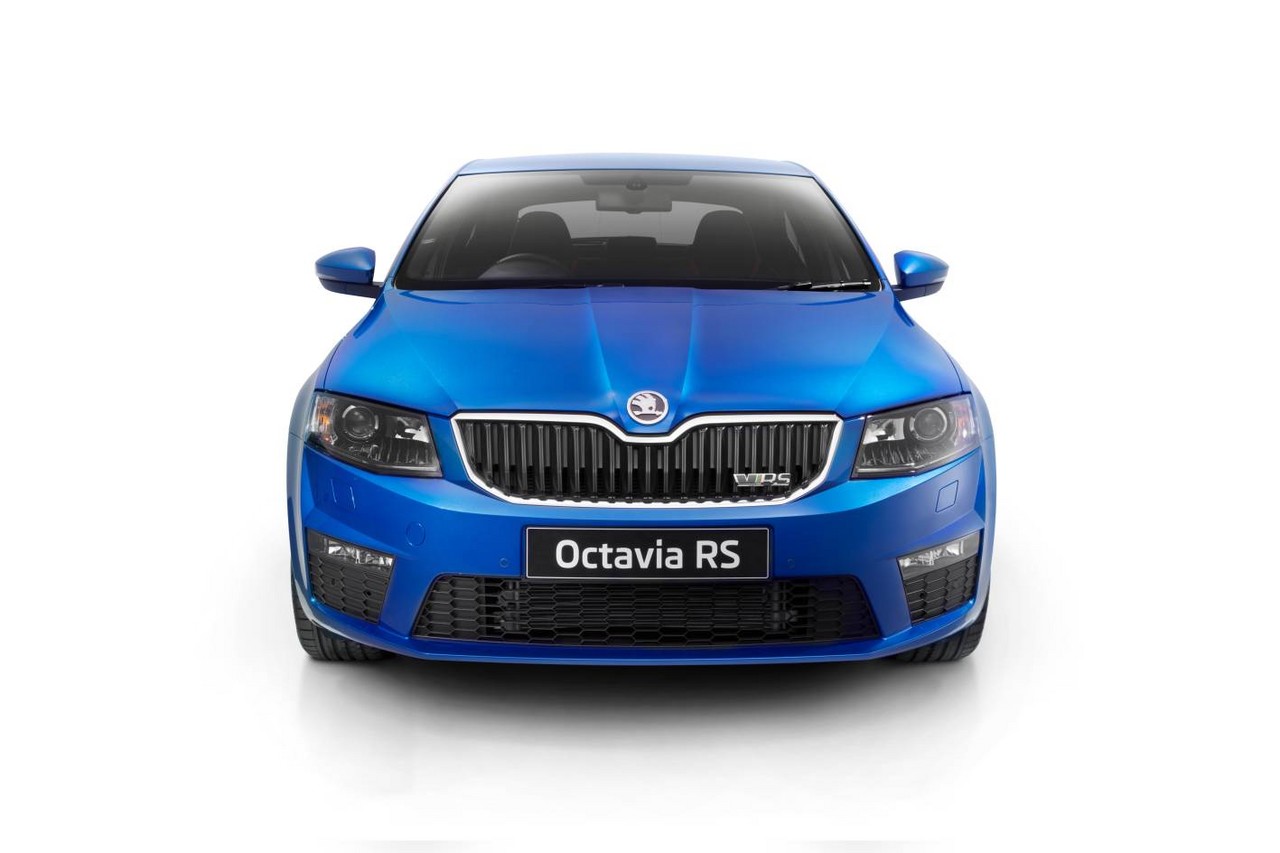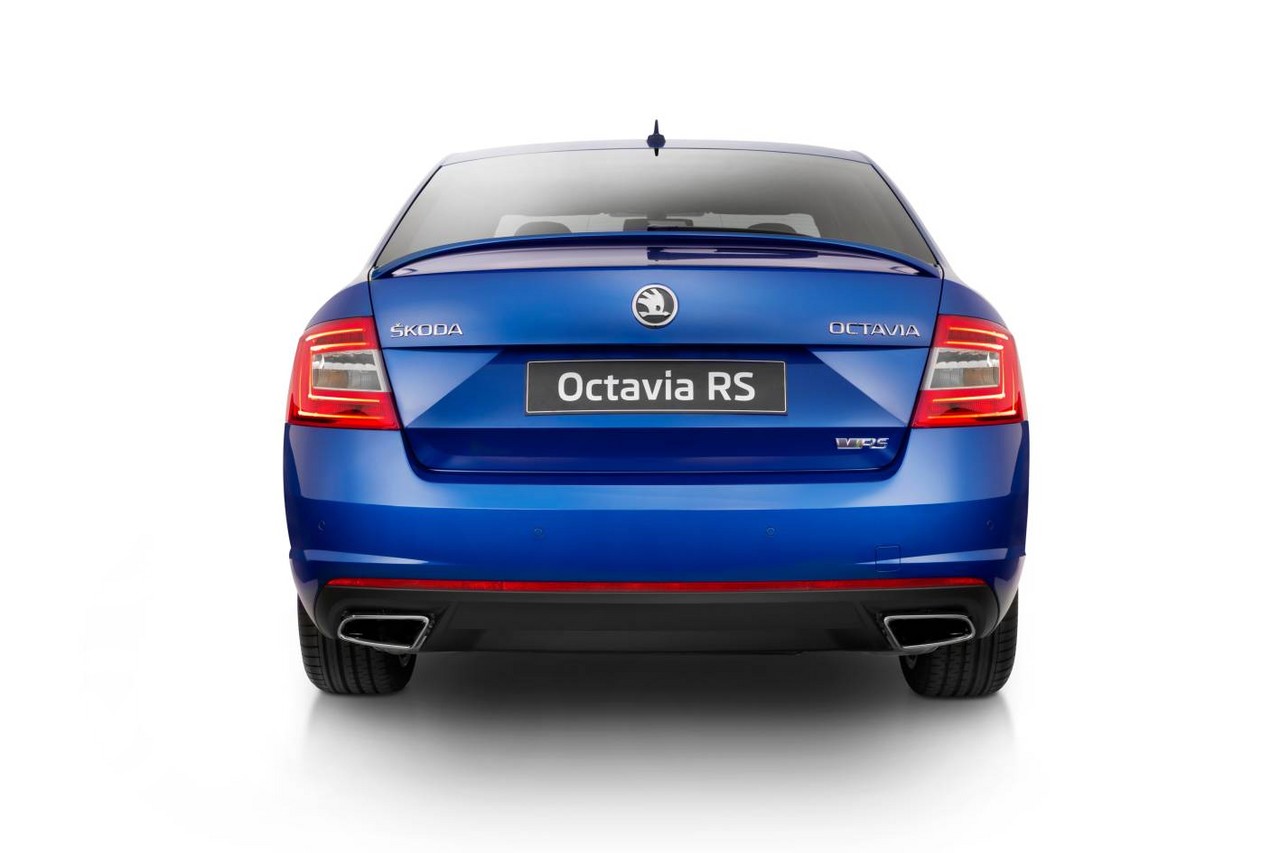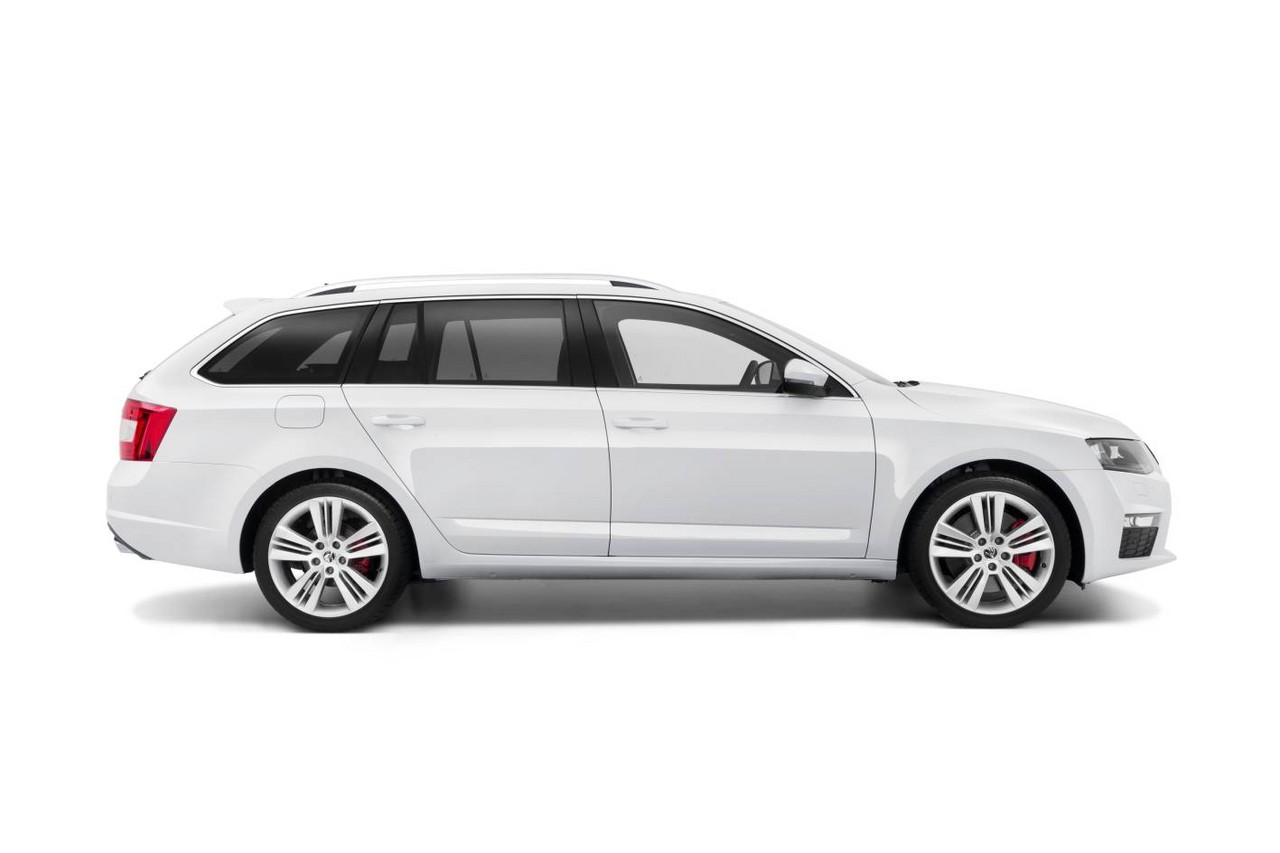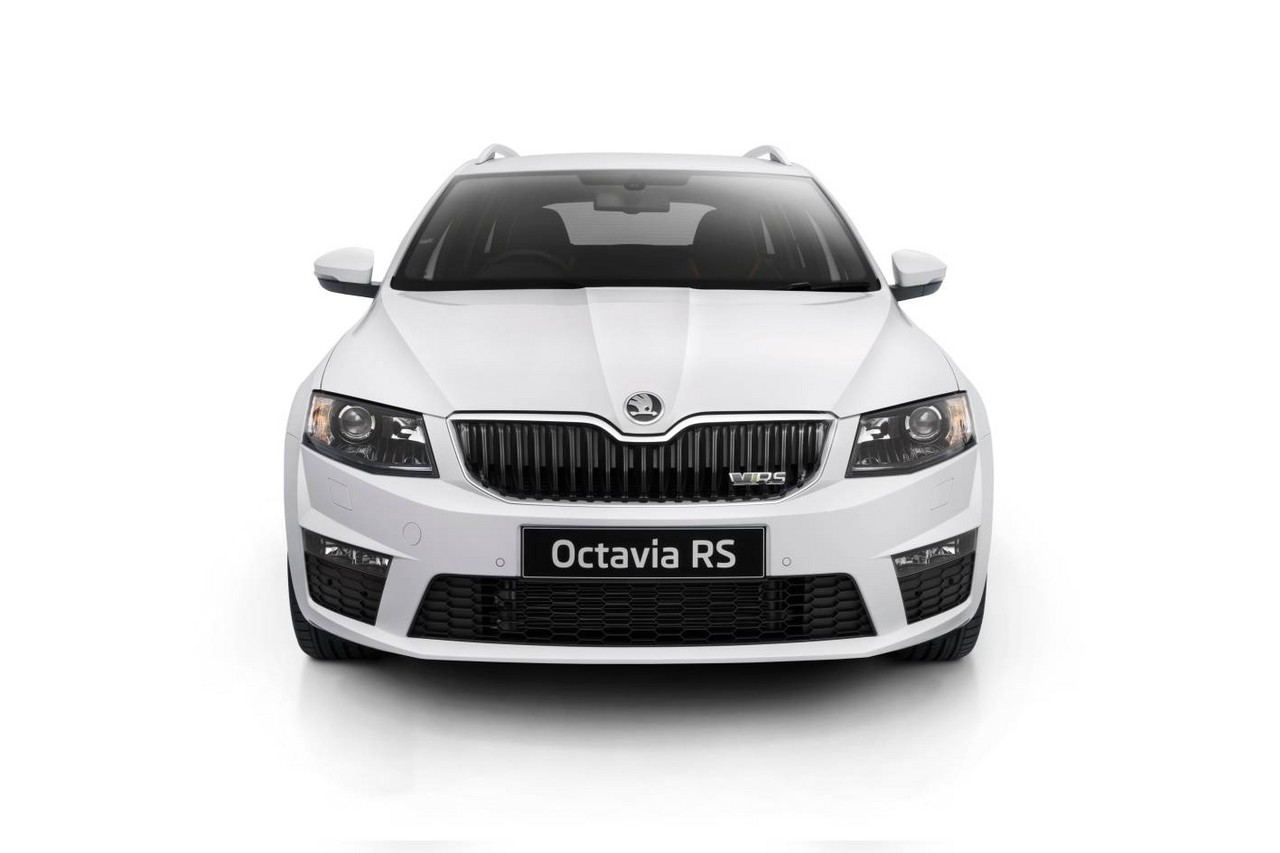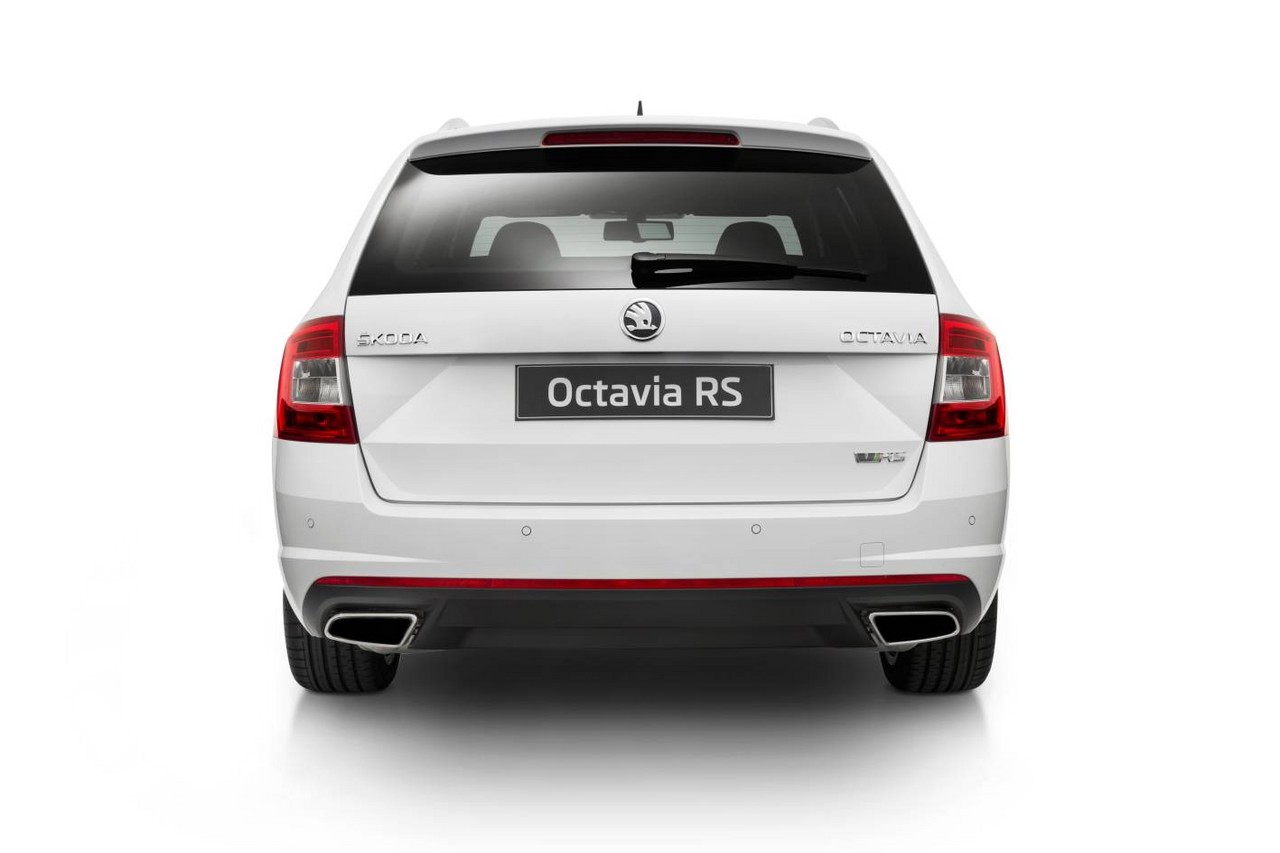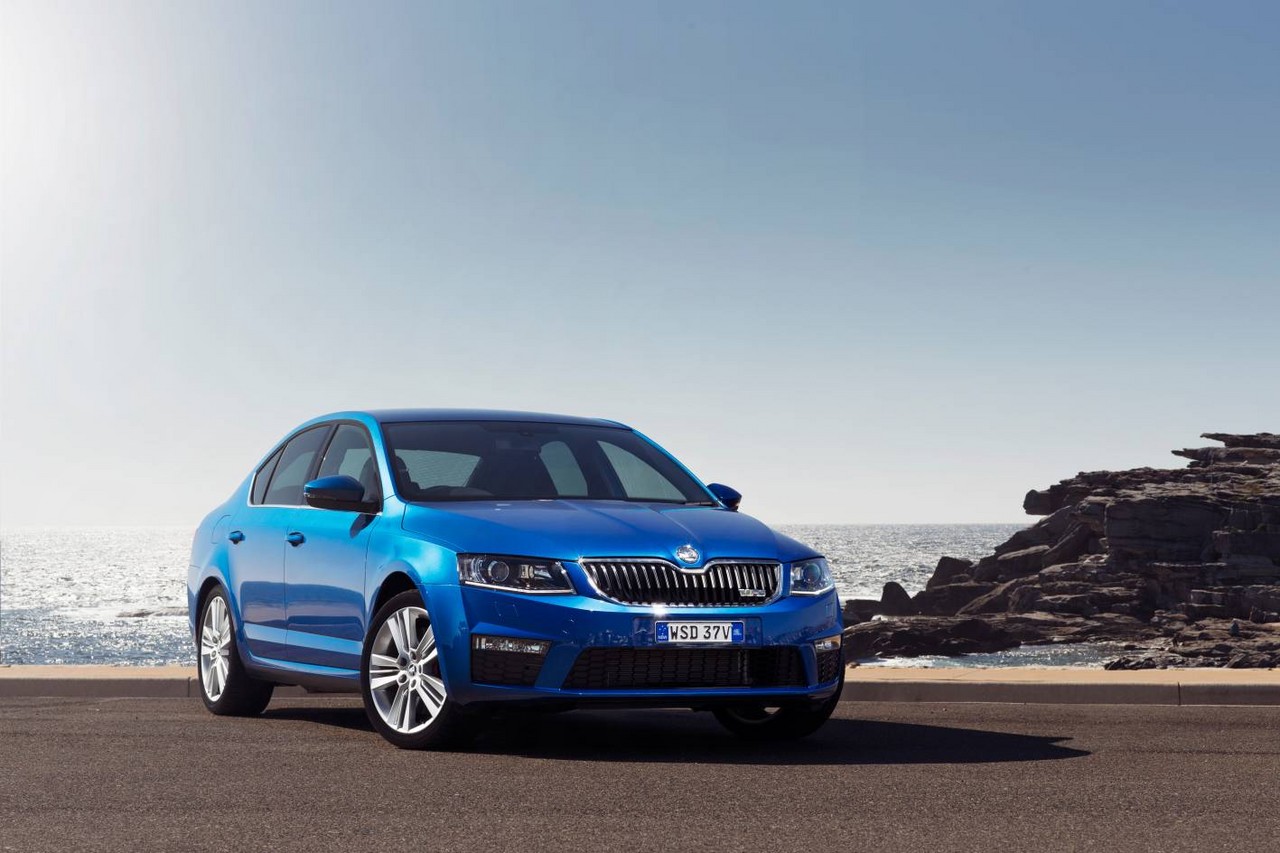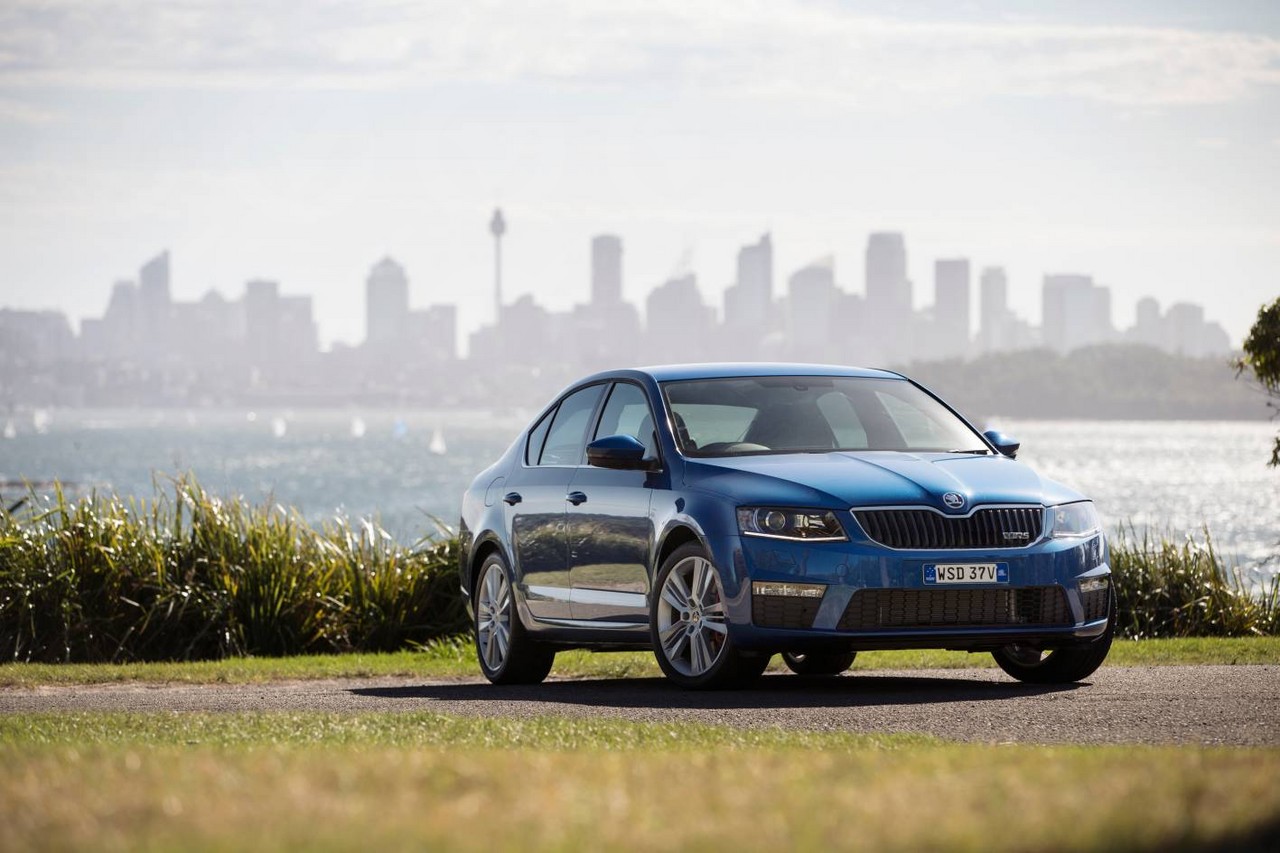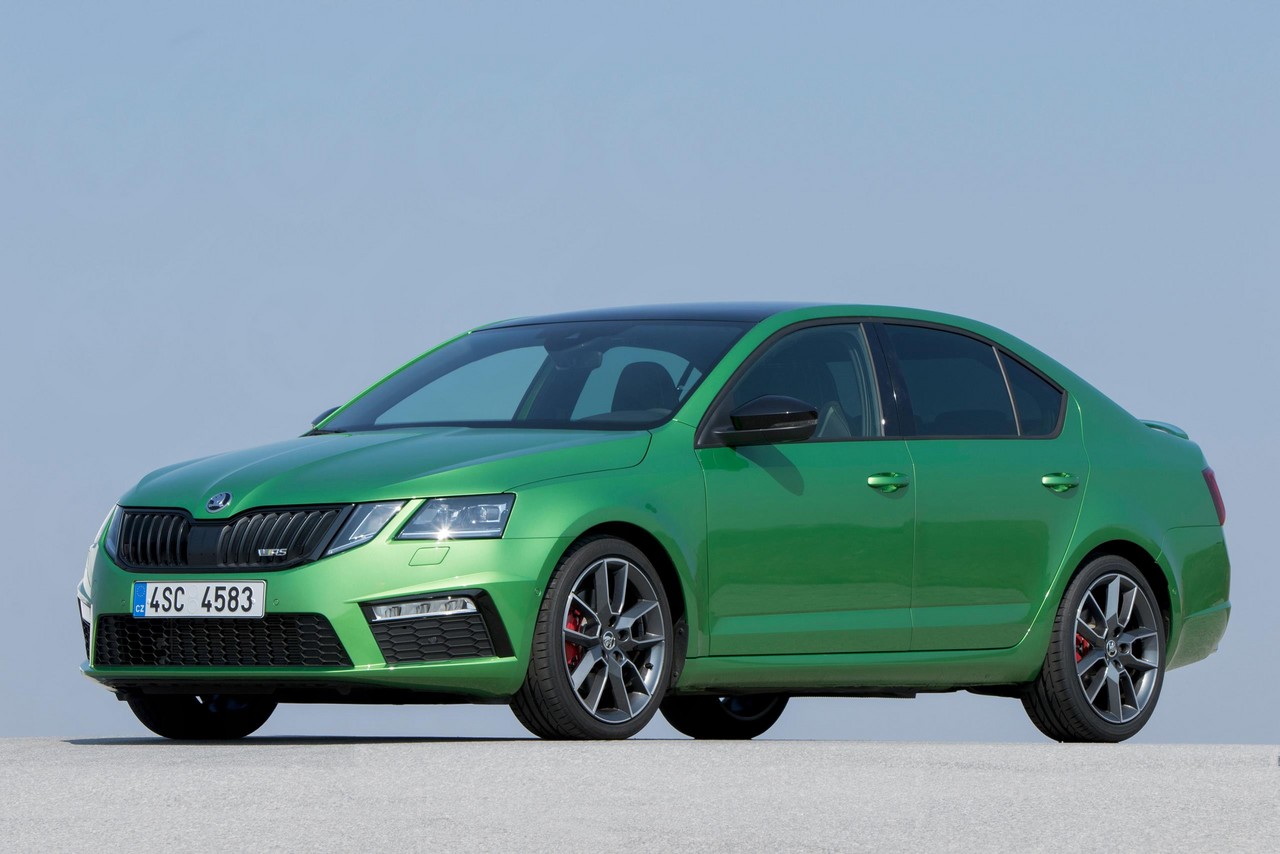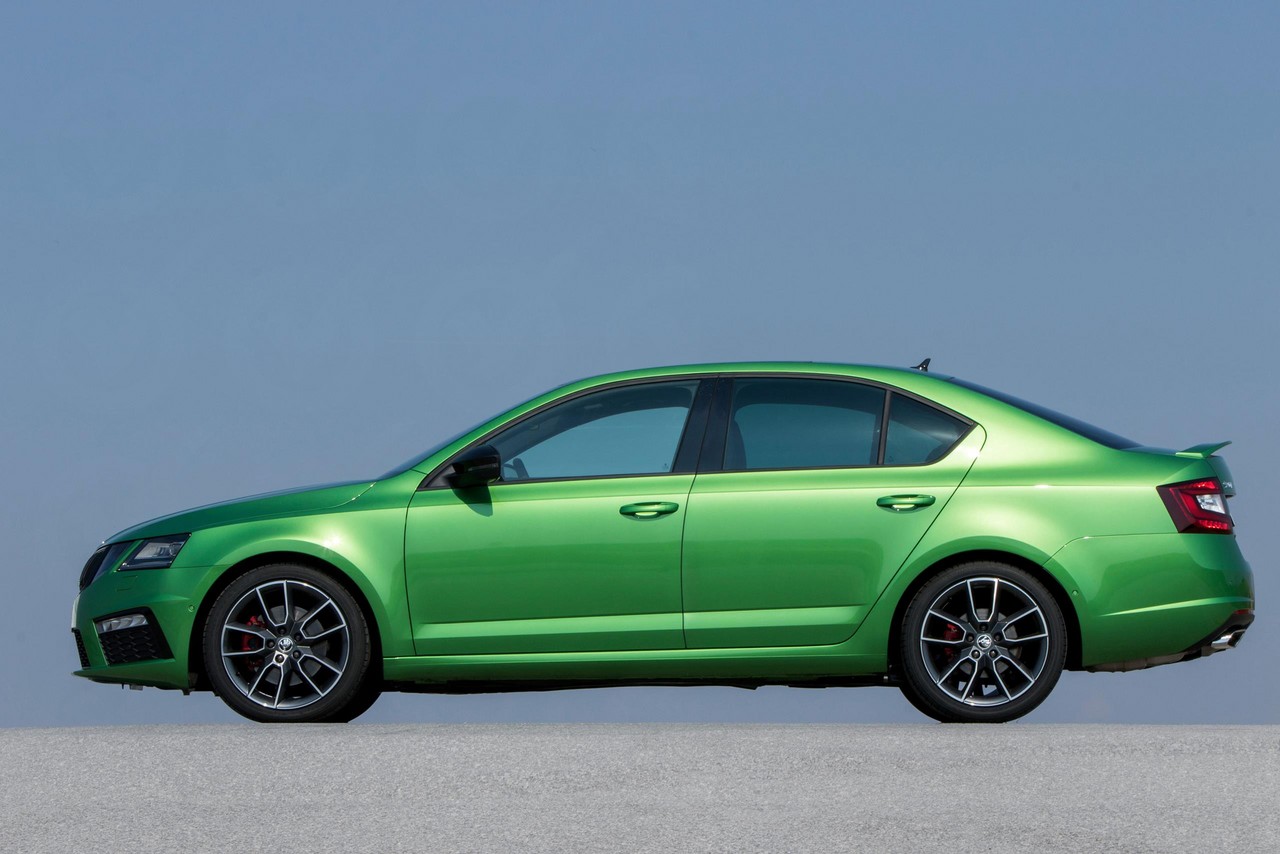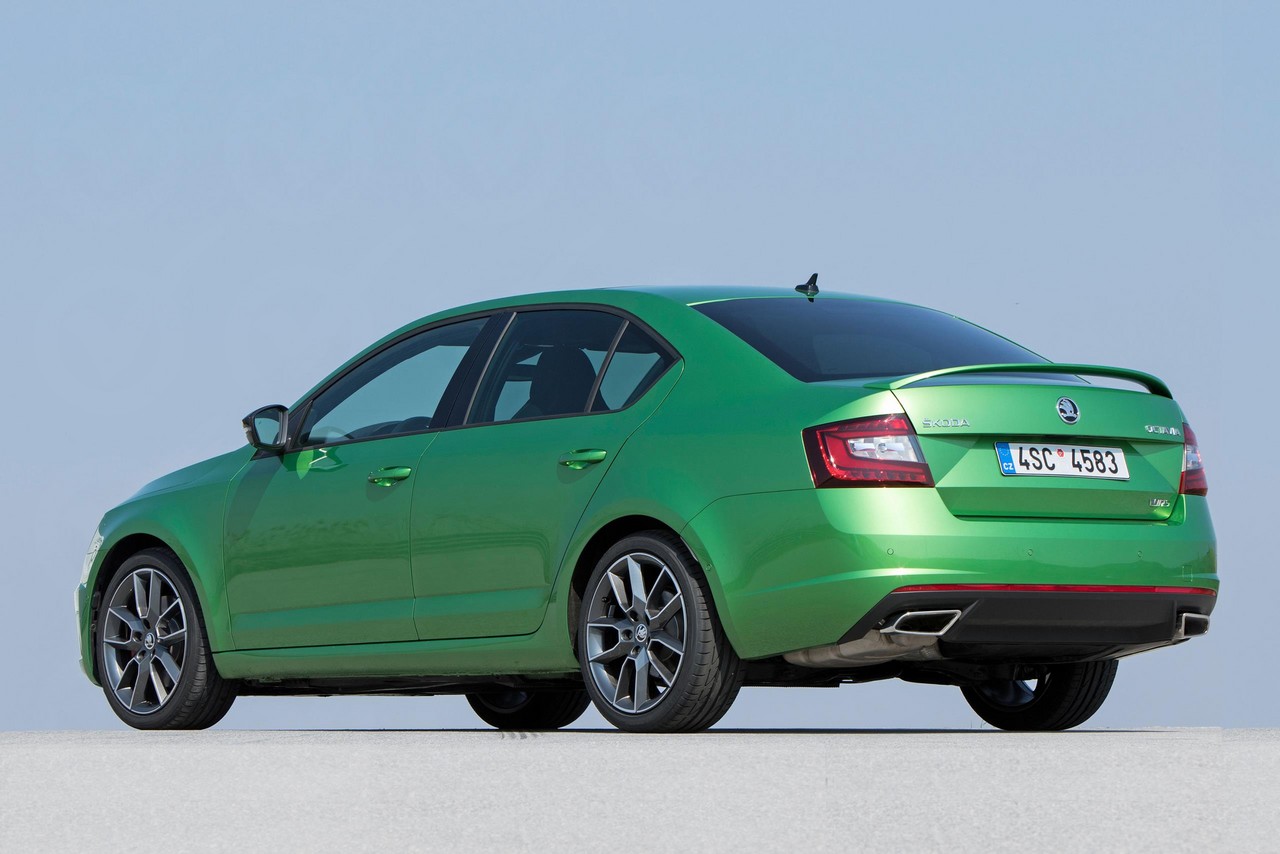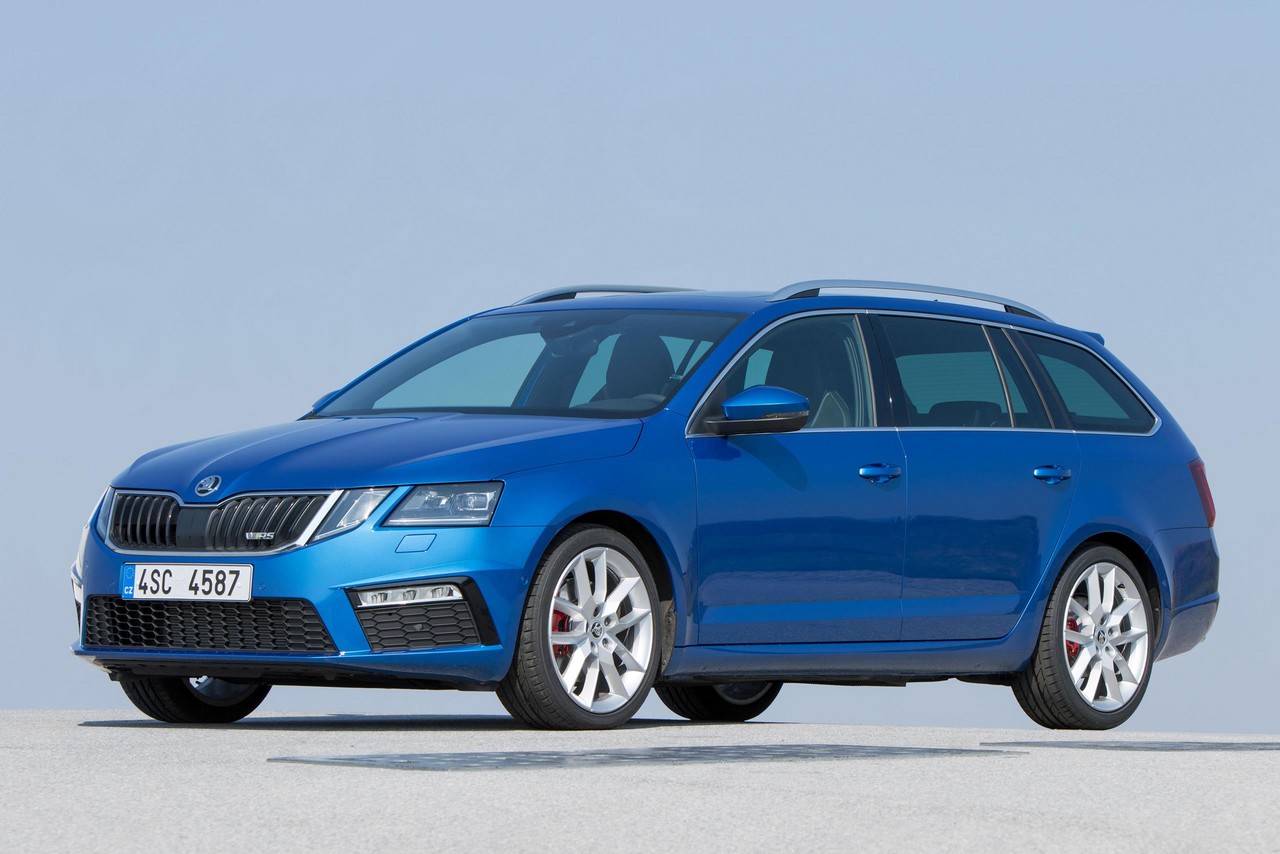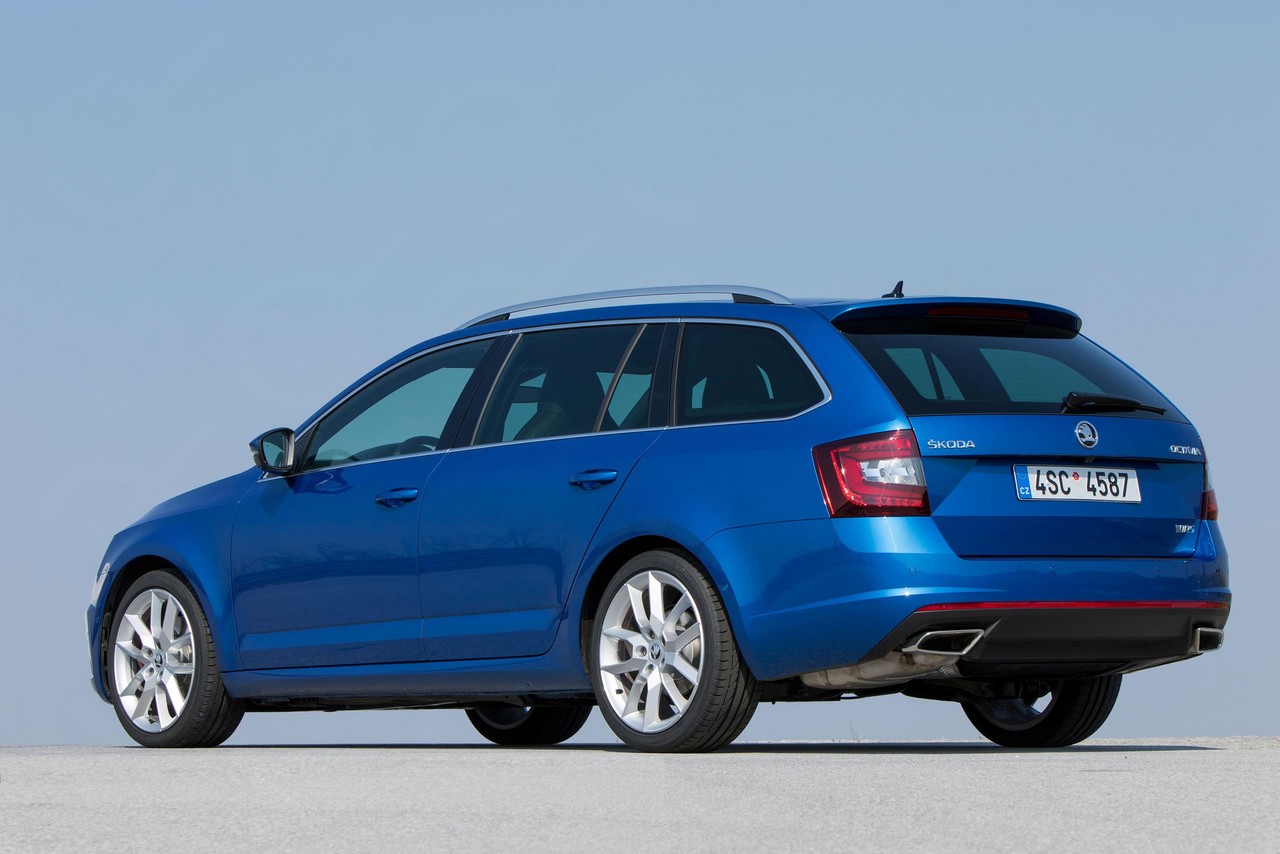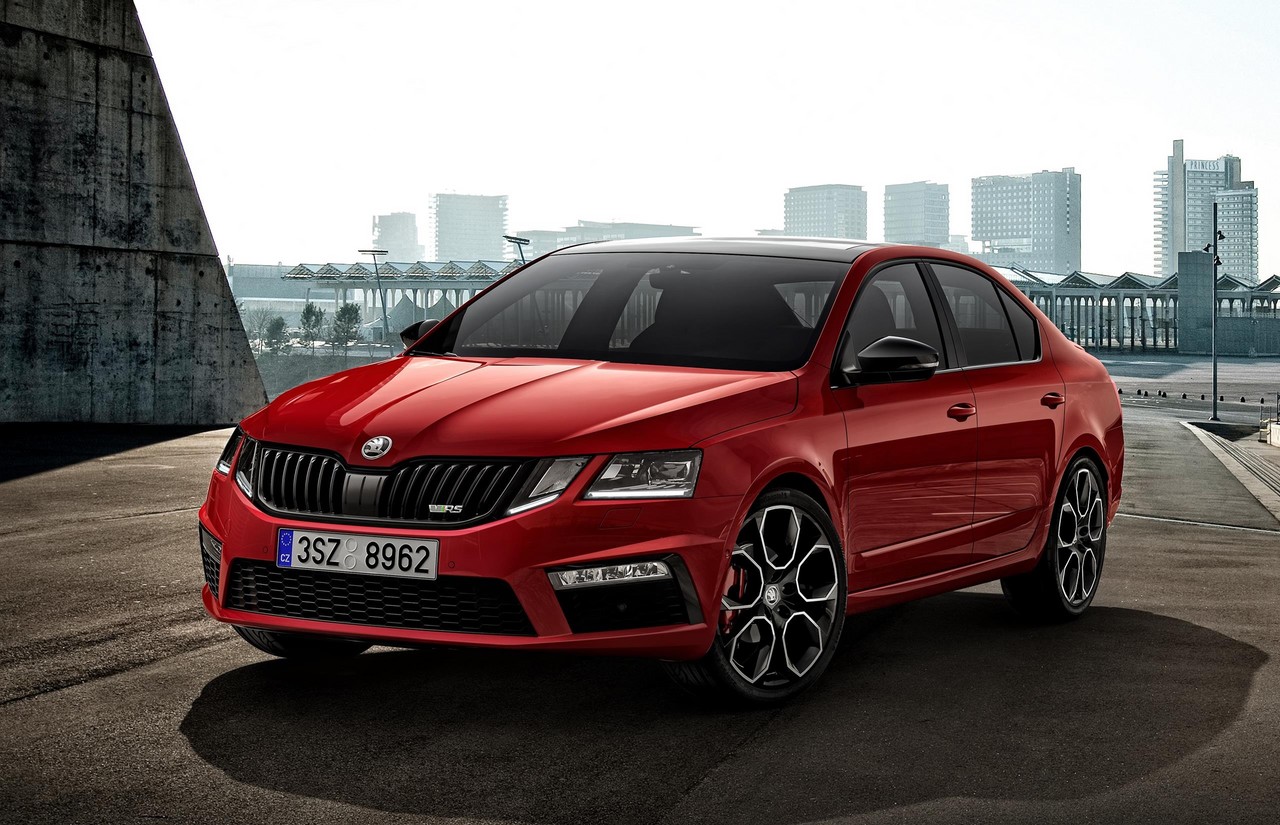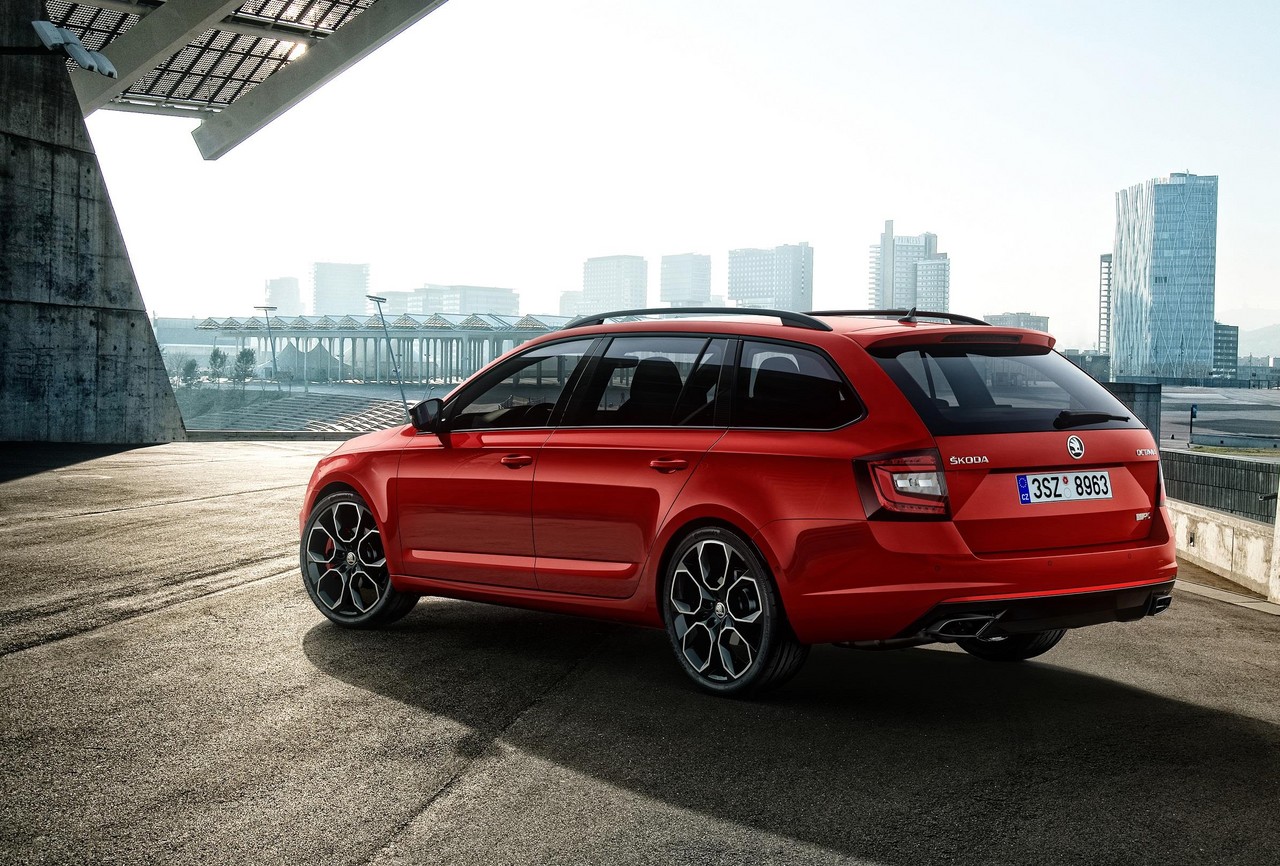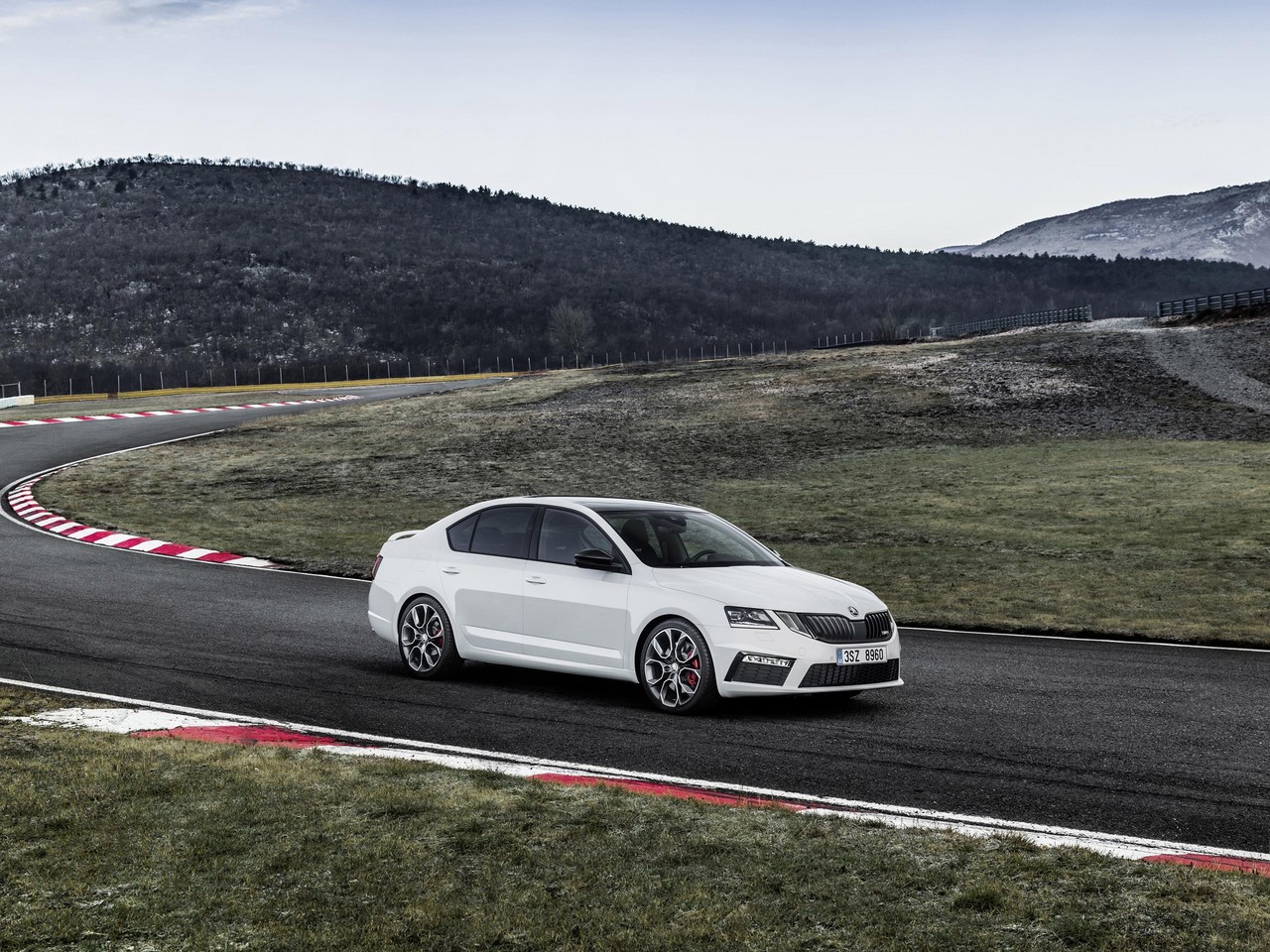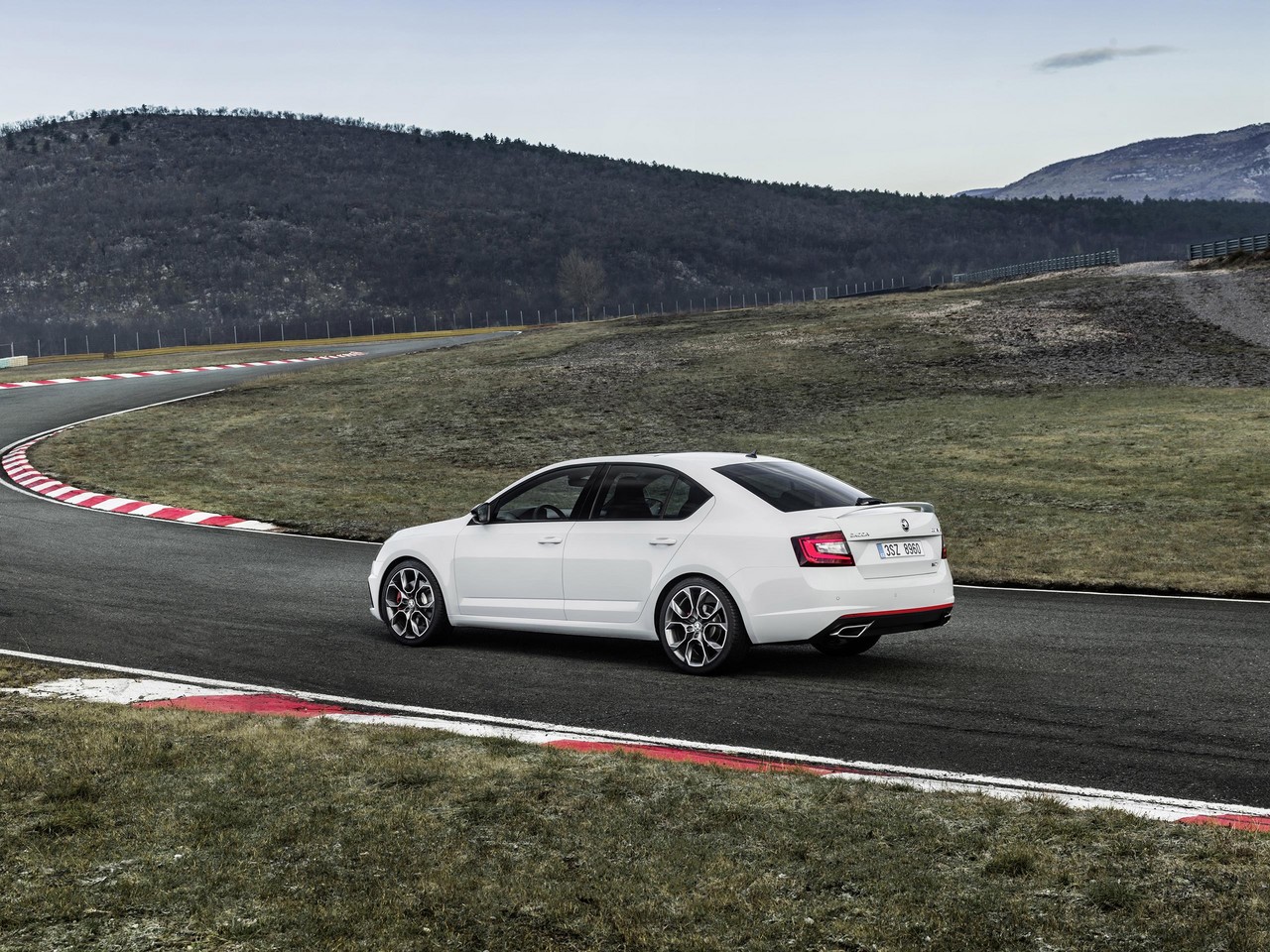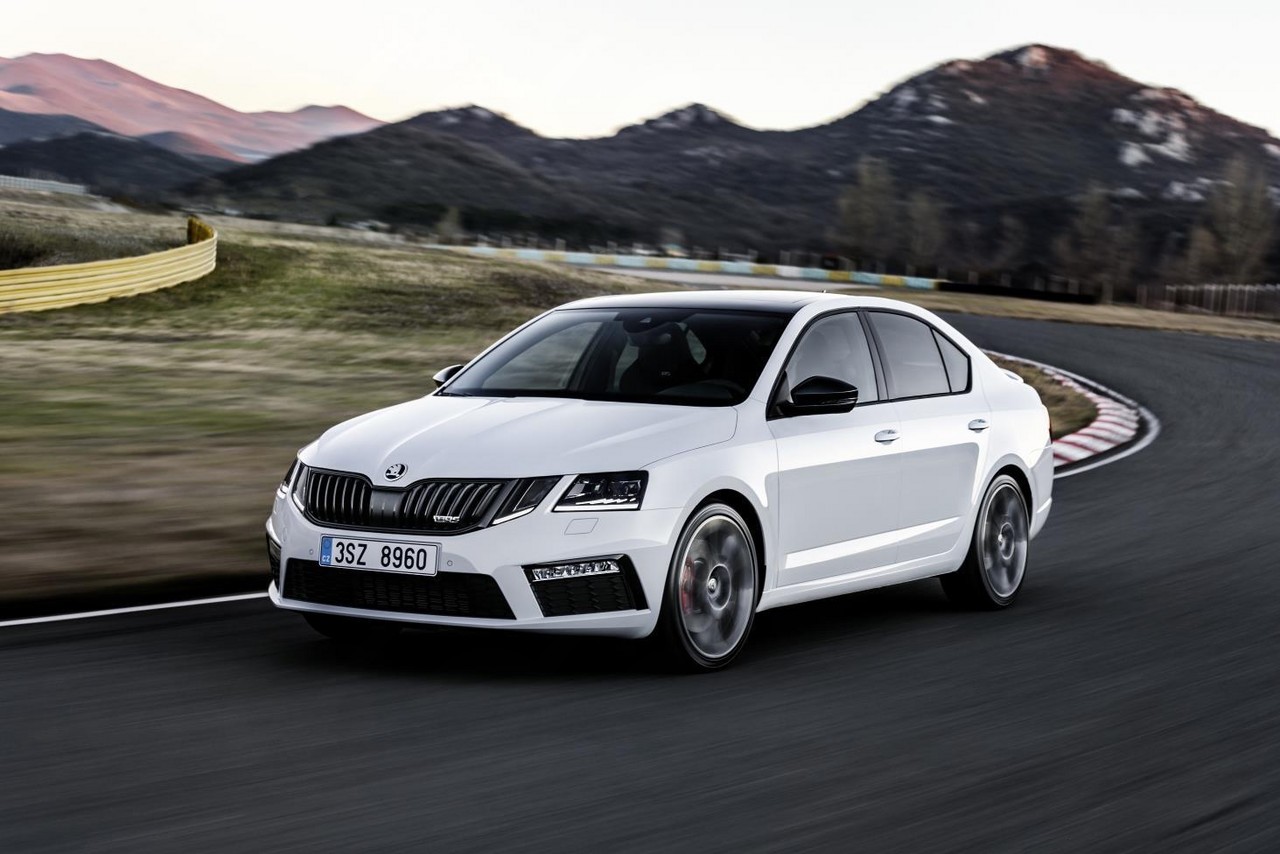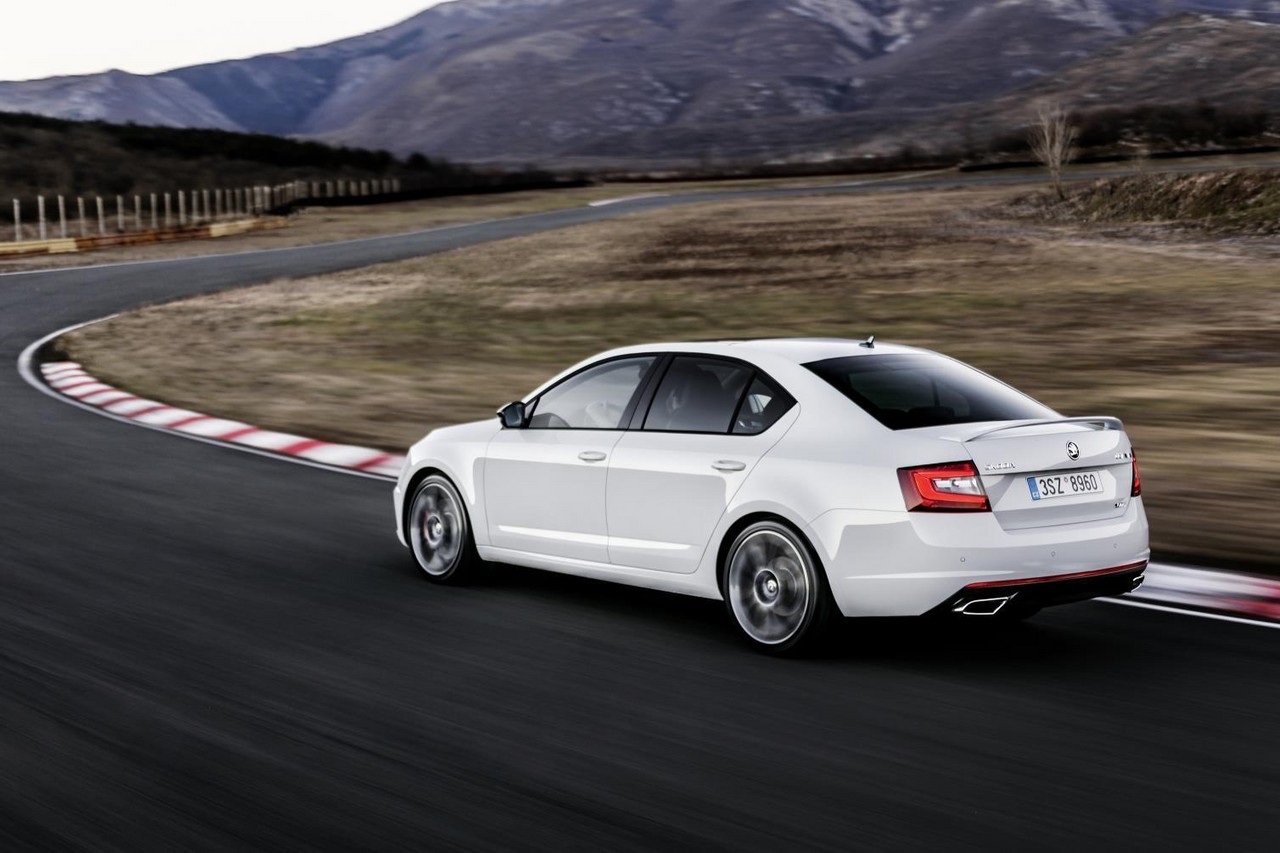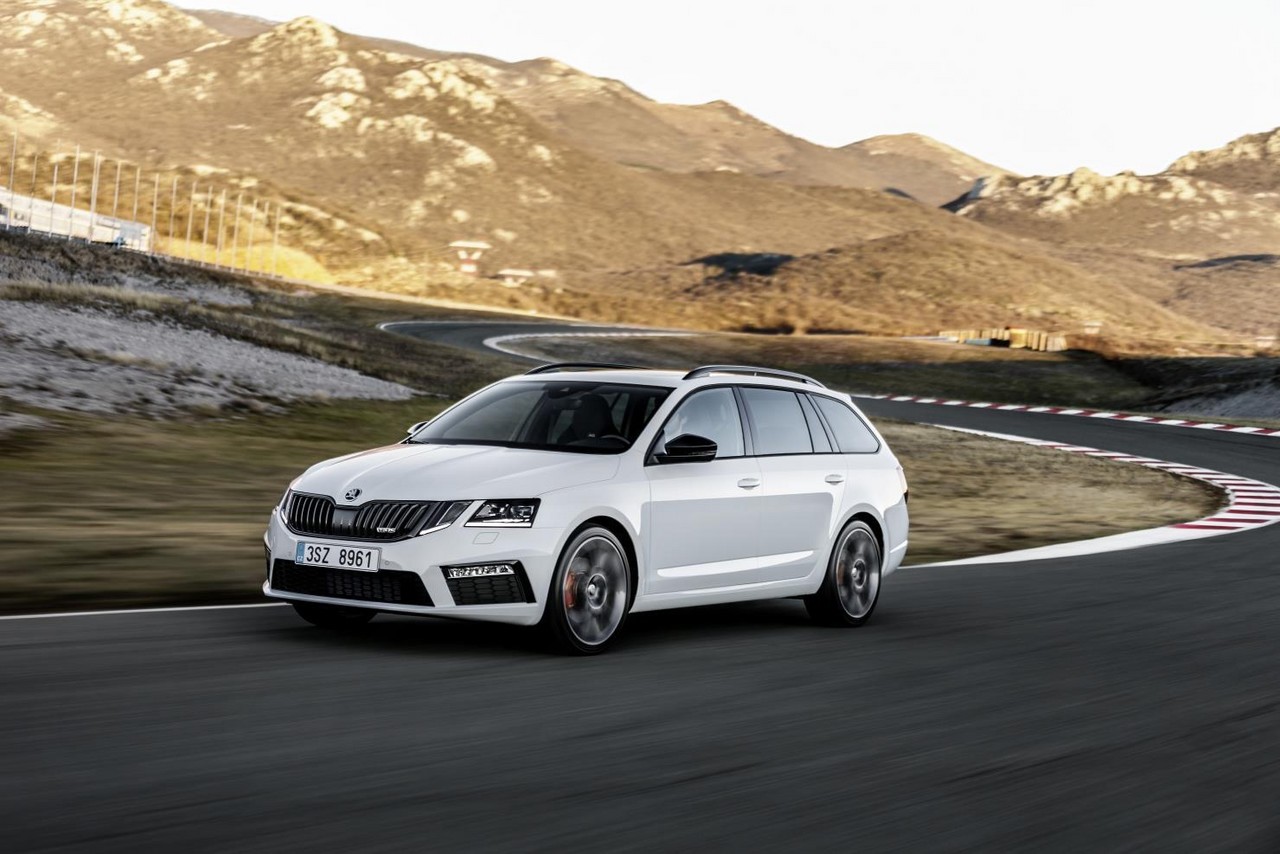
- Powerful 2.0-litre turbo petrol engine
- Economical and responsive 2.0-litre turbo-diesel engine
- Impressive dynamics and surprisingly compliant ride
- Accurate steering
- High standard of interior fit and finish
- Wind noise at highway speeds
- Lacks involvement of related VW Mk.7 Golf GTi
Review: Skoda 5E.I Octavia RS (2014-17)
Overview
Released in Australia in April 2014, the Skoda 5E Octavia RS and Octavia Combi RS were mid-size liftbacks and wagons, respectively (the standard Skoda 5E Octavia has been reviewed separately). Manufactured in Mlada Boleslav, Czech Republic, the front-wheel drive Skoda Octavia RS was powered by 2.0-litre turbocharged petrol and diesel engines. As per the table below, both engines were offered with six-speed manual and double clutch transmissions (DCT or Volkswagen’s ‘DSG’).
In November 2016, the Octavia RS range was expanded with the Octvia RS 230 which shared its engine with the Volkswagen Mk.7 Golf GTi Performance .
162TSI and 135TDI engines
Shared with the Volkswagen Mk.7 Golf GTi , the 1984 cc EA888 four-cylinder petrol engine had a grey cast iron block with an 82.5 mm bore and a 92.8 mm stroke, a die-forged steel crankshaft with five main bearings, a cast aluminium alloy cylinder head, direct injection and multi-point port injection, an intercooler, double overhead camshafts (toothed chain-driven), variable intake and exhaust camshaft timing, variable exhaust valve lift (two-stage), roller finger cam followers with hydraulic valve clearance compensation, four valves per cylinder, a variable intake manifold and a compression ratio of 9.6:1. Although not confirmed, it is understood the 162TSI engine had an IHI turbocharger which provided peak boost pressure of 1.2 bar (17.4 psi).
The EA288 turbo-diesel engine had a grey cast iron block with an 81.0 mm bore and a 95.5 mm stroke, a die-forged steel crankshaft with five main bearings, fracture-split forged steel connecting rods, Bosch common-rail injection (operating at 2000 bar), a turbocharger, an intercooler integrated in the intake manifold, an alloy cylinder head, double overhead camshafts (belt-driven), four valves per cylinder, variable valve timing, dual-loop exhaust gas recirculation (EGR), a diesel particulate filter and a compression ratio of 15.8:1. To reduce engine vibrations, the EA288 engine had two counter-rotating balancer shafts with low friction bearings.
To reduce fuel consumption, both engines featured Start-Stop technology (i.e. engine shut down when the vehicle stationary in traffic) and Brake Energy Regeneration (which regulates alternator output to recharge the battery when the vehicle is coasting or braking).
| Variant | Engine | Trans. | Peak power | Peak torque |
|---|---|---|---|---|
| 162TSI | 2.0-litre CHHB turbo petrol I4 | 6sp man., 6sp DSG |
162 kW at 4500-6200 rpm | 350 Nm at 1500-4400 rpm |
| 230 | 2.0-litre CHHA turbo petrol I4 | 6sp man., 6sp DSG |
169 kW at 4700-6200 rpm | 350 Nm at 1500-4600 rpm |
| 135TDI | 2.0-litre CUPA turbo-diesel I4 | 6sp DSG | 135 kW at 4000 rpm | 380 Nm at 1750-3000 rpm |
Dimensions
Compared to the Skoda 1Z Octavia RS , the Skoda 5E Octavia RS was 102 mm longer (at 4685 mm), 45 mm wider (1814 mm), 3 mm taller (1450 mm) and had a 102 mm longer wheelbase (2680 mm). With the rear seats in position, cargo capacity for the sedan and Combi were 568 and 588 litres respectively.
Suspension and steering
The Skoda 5E Octavia RS had MacPherson strut front suspension (with lower triangular links and a torsion stabiliser) and independent, multi-link rear suspension. Furthermore, the Skoda Octavia RS had rack-and-pinion steering with electric power assistance.
Safety equipment
Standard safety equipment for the Skoda 5E Octavia RS included dual front airbags, a driver’s knee airbag, front and rear side airbags, full-length curtain airbags, ABS, electronic brake force distribution, brake assist, electronic stability control, traction control, fatigue detection and front seatbelts with pre-tensioners and load limiters.
From mid-2014, the Octavia RS was available with an optional ‘Tech Pack’ which included:
- Adaptive Cruise Control (ACC): when cruise control was engaged at speeds between 30 km/h and 160 km/h, ACC would use a radar sensor to maintain a safe distance from the vehicle in front, controlling the engine and brakes accordingly;
- Front Assist: operated at speeds of up to 150 km/h and used a radar sensor to monitor the distance to the vehicle ahead. In the event of a potential collision, Front Assist operated in four stages: 1) a visual warning; 2) visual and acoustic warnings and preparation of the braking system; 3) increasing braking pressure and initiation of automatic partial braking; and, 4) if the driver failed to react, emergency braking; and,
- City Emergency Braking: a component of Front Assist, City Emergency Braking operated at speeds between 5 km/h and 30 km/h. If the driver failed to react to an obstacle in front of the vehicle, City Emergency Braking would initiate an emergency stop with a maximum deceleration of 8 m/s2.
From May 2016, however, these technologies were fitted as standard for the Octavia RS. The Tech Pack also included a rear view camera, Automatic Parking Assist, Canton sound system and proximity key.
Euro NCAP testing
In Euro NCAP testing , a 2013 Skoda 5E Octavia – fitted with a 1.6-litre petrol engine – received a five star safety rating which included a 93 per cent adult occupant protection rating and an 86 per cent child occupant protection rating. In the offset crash test, occupant protection was generally rated as good, though lower leg protection for the driver was assessed as adequate. Maximum points were awarded in the side impact test though, in the more severe pole test, chest protection was adequate and thorax protection was weak.
Features: Octavia RS 162TSI and 135TDI
Standard features for the Skoda Octavia RS included 18-inch ‘Pictoris’ alloy wheels with 225/40 R18 tyres and a space-saver spare, an eight speaker sound system with auxiliary inputs (3.5 mm, USB, SD cards), Bluetooth connectivity and voice recognition, a Columbus satellite navigation system with an eight-inch touch screen, combination leather/fabric seat upholstery, dual-zone climate control air conditioning, an air conditioned glove box, cruise control, bi-xenon headlights with washers, daytime LED running lights, front and rear fog lights, automatic headlights, rain-sensing wipers, front and rear parking sensors, a three-spoke leather steering wheel, leather-wrapped hand brake and gear lever handles, 60/40 split and folding rear seats, remote central locking, power windows and heated mirrors, height adjustable front seats, ambient lighting, an electrochromatic rear view mirror, tyre pressure monitoring, two 12 volt power sockets, tinted windows, trip computer, an alarm and immobiliser. Models with DSG transmissions will also be fitted with steering wheel gearshift paddles.
Beyond this,
- Octavia RS models with DSG transmissions were also fitted with steering wheel gearshift paddles; and,
- The Octavia RS Combi was further equipped with a cargo cover, foldable hooks in the cargo area and silver roof rails.
Extended Electronic Differential Lock (XDL)
As standard, the Skoda Octavia RS was equipped with an ‘Extended Electronic Differential Lock’ (XDL). An extension of the reactive EDL on the standard Skoda 5E Octavia, the XDL used electronic stability control (ESC) hydraulics to apply the brakes to the inside cornering wheel to prevent wheel spin before it occurred – this improved traction and reduced the tendency to understeer.
October 2014 and July 2015 updates
From October 2014, the Octavia RS was fitted with a rear view camera as standard. Furthermore, an optional Comfort Pack was introduced which included leather upholstery with red stitching, power adjustable front seats, heated front and rear seats, and power-folding door mirrors.
In July 2015, the Columbus system was upgraded to include WiFi connectivity and Skoda’s ‘SmartLink’ system which included Apple CarPlay and Android Auto smartphone integration.
2016 Skoda Octavia RS 230
Officially released in Australia in November 2016, the Skoda Octavia RS 230 was available in liftback and wagon bodies. Compared to the standard Skoda Octavia RS, the Octavia RS 230 was further equipped with black leather appointed seat upholstery with red stitching, automatically foldable door mirrors with auto dimming and memory function, stainless steel foot pedals with rubber inserts and had a lap timer function in the car’s colour multifunction display. Visual cues for the Skoda Octavia RS 230 included 7.5J x 19-inch ‘Xtreme black’ alloy wheels, and black finishes for the grille surround, door mirror caps, rear spoiler and exhaust tailpipe.
In contrast to the standard Octavia RS, the Skoda Octavia RS 230 was fitted with Skoda’s electronically controlled front axle inter-wheel lock (VAQ) which included an electronically controlled multi-plate clutch that was located between the differential and the right-hand side powered axle. Previously introduced in the Seat Leon Cupra (see video below), its operation can be described as follows:
- When cornering, transfer loads charge the outside wheel and discharge the inside wheel, reducing traction and increasing the possibility of wheelspin during acceleration;
- When the inner wheel was rotating faster than the outside wheel, the VAQ adjusted the torque delivered to the inner wheel and increased torque to the outer wheel. By directing additional power to the outer wheel which had traction, power losses were reduced and driveshaft torque delivery was more efficient. Furthermore, the system also reduced understeer by generating a yaw effect; and,
- According to Skoda, 100 per cent of the engine’s torque could be directed to either front wheel.
Brochure
Related links
- Press Kit: Skoda 5E Octavia RS (March 2014)
- Technical Specifications: Skoda 5E Octavia RS (March 2014)
- Specifications: Skoda 5E Octavia and Octavia RS (October 2014)
- Specifications: Skoda 5E Octavia and Octavia RS (June 2016)
- Specifications: Skoda 5E Octavia RS 230 (November 2016)
Review: Skoda 5E.II Octavia RS (2017-20)
Overview
Released in Australia in April 2017, the Skoda 5E Series II (5E.II) Octavia RS range consisted of 169TSI and 135TDI variants, with the Octavia RS 245 following in October 2017.
Visually, the Skoda 5E.II Octavia RS could be identified by its quad headlight design ‘with a crystalline look’, wider radiator grille and more prominent Skoda logo on the bonnet. Inside, the Skoda 5E.II Octavia RS introduced new infotainment systems which had capacitive displays and revised air conditioning controls.
In September 2018, the Skoda Octavia RS range was revised as:
- The 135TDI variant was withdrawn from the Australian market;
- The 169TSI variant was effectively replaced by an entry-level variant (simply the Octavia RS) which was powered by the same engine as the RS 245 which had been introduced in October 2017; and,
- Six-speed manual transmissions were also withdrawn from the Australian market.
| Variant | Years | Engine | Trans. | Peak power | Peak torque |
|---|---|---|---|---|---|
| 169TSI | 2017-18 | 2.0-litre CHHA turbo petrol I4 | 6sp man., 6sp DSG |
169 kW at 4700-6200 rpm | 350 Nm at 1500-4600 rpm |
| RS | 2018-20 | 2.0-litre DLBA turbo petrol I4 | 6sp man., 7sp DSG |
180 kW at 4700-600 rpm | 370 Nm at 1600-4300 rpm |
| 135TDI | 2017-18 | 2.0-litre CUNA turbo-diesel I4 | 6sp DSG | 135 kW at 4000 rpm | 380 Nm at 1750-3000 rpm |
| 245 | 2017-20 | 2.0-litre DLBA turbo petrol I4 | 6sp man., 7sp DSG |
180 kW at 4700-600 rpm | 370 Nm at 1600-4300 rpm |
Safety equipment
Compared to the post-May 2016 Skoda 5E.II Octavia RS, standard safety equipment for the Skoda 5E.II Octavia RS was extended to include the following technologies:
- ‘Predictive Pedestrian Protection’: an extension of Front Assist, the Predictive Pedestrian Protection operated at speeds between 10 km/h and 60 km/ and would initiate an emergency stop if a pedestrian attempted to cross the Skoda Octavia’s path. At speeds above 40 km/h, an additional collision warning would be issued; and,
- Passenger Protect Assist (also known as Crew Protect Assistant): operating at speeds above 30 km/h, Passenger Protect Assist could detect when an emergency manoeuvre was being performed and would use the electrical front seatbelt pre-tensioners to remove slack from the seatbelts. In cases where high lateral accelerations were detected, the Passenger Protect Assist would also close the side windows and sunroof (where fitted) to prevent objects coming into the passenger compartment in the event of a collision.
The Skoda 5E.II Octavia RS could be specified with an optional, extra-cost ‘Luxury Pack’ which included the following active safety technologies –
- Lane Assist: used a camera positioned within the rear-view mirror to detect lane markings. If the system detected that the Skoda Octavia was about to depart from its lane, corrective steering torque would be applied to direct the Octavia back to the centre of its lane; and,
- Blind Spot Detection: used two radar sensors in the lower part of the rear bumper to monitor the area beside and up to 20 metres behind the Skoda Octavia. If a vehicle was detected in the driver’s blind spot or approaching from behind, an LED symbol in the door mirror would illuminate to alert the driver. If the driver indicated in the direction of the detected vehicle, the LED would flash as an additional alert.
The Luxury Pack also included Alcantara and leather seat upholstery, power adjustable front seats with driver’s seat memory settings, heated seats (front and rear) and auto-dimming door mirrors.
Features: Skoda Octavia RS
Standard features for the Skoda 5E.II Octavia RS included 7.5J x 18-inch ‘Alaris’ alloy wheels with 225/40 R18 tyres, an eight speaker sound system, ‘Columbus’ satellite navigation system with a 9.2-inch touch screen, Skoda’s ‘SmartLink’ smartphone integration (Apple CarPlay and Android Auto), Bluetooth mobile phone connectivity and audio streaming with voice control, 3.5 mm auxiliary and USB inputs, two SD card slots, dual-zone ‘Climatronic’ air conditioning, leather and fabric seat upholstery with red stitching, LED headlights with adaptive front lighting, directional front fog lights, LED daytime running lights, dusk-sensing headlights, rain-sensing wipers, a rear view camera, front and rear parking sensors, leather-wrapped steering wheel, 60/40 split folding rear seats, remote central locking, power adjustable and heated door mirrors, power windows, height adjustable front seats with lumbar support, an auto-dimming rear view mirror, LED interior ambient lighting, 12 volt power sockets (centre console and luggage compartment), aluminium finishes for the pedals, rear privacy glass, a trip computer and an immobiliser.
Skoda Octavia RS wagons were also fitted with roof rails, an LED torch in the luggage compartment and a rolling cargo cover.
Visual cues for the Skoda 5E.II Octavia RS included a black grille surround and door mirror caps, red brake callipers, chrome exhaust tailpipes, ‘RS’ badging and black rear diffuser.
Skoda Octavia RS 245
Released in Australia in October 2017, the Skoda Octavia RS 245 was powered by the higher-output 2.0-litre DLBA turbocharged petrol engine which produced peak outputs of 180 kW and 370 Nm; the RS 245 was also available with a seven-speed double clutch transmission. With this powertrain, the Octavia RS 245 could accelerate from rest to 100 km/h in 6.6 seconds (6.7 seconds for the wagon). Like the Octavia RS 230, the Octavia RS 245 was fitted with electronically controlled front axle inter-wheel lock (VAQ, described above).
Compared to the Octavia RS 169TSI, standard features for the Octavia RS 245 were extended to include combination leather and Alcantara seat upholstery, power adjustable front seats, driver’s seat memory function, door mirrors with automatic dimming and folding functions, a unique ‘RS 245’ instrument cluster and door inserts.
Visually, the Octavia RS 245 could be identified by its 19-inch ‘Xtreme’ alloy wheels with gloss black finish, gloss black radiator grille surround and slats, black door mirror housings and black trapezoid tailpipes. The Octavia RS 245 was available in four paint finishes: Corrida Red, Steel Grey, Moon White (metallic) and Black Magic (pearl effect).
From September 2018 deliveries, the Skoda Octavia RS 245 was equipped – as standard – with ‘Adaptive Chassis Control’ (i.e. electronically controlled dampers that varied damping resistance according to road conditions and driver behaviour; the driver could also select from Comfort, Normal and Sport modes).
Brochure
- Brochure: Skoda 5E.II Octavia and Octavia RS (April 2017)
- Brochure: Skoda 5E.II Octavia and Octavia RS (October 2017)
Related links
